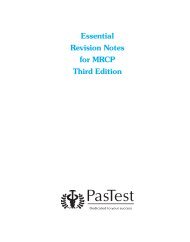OSCEs for Medical Students, Volume 3 Second Edition
OSCEs for Medical Students, Volume 3 Second Edition
OSCEs for Medical Students, Volume 3 Second Edition
You also want an ePaper? Increase the reach of your titles
YUMPU automatically turns print PDFs into web optimized ePapers that Google loves.
132 <strong>OSCEs</strong> <strong>for</strong> <strong>Medical</strong> <strong>Students</strong>, <strong>Volume</strong> 3AnswersCommentNeurology cases in paediatric <strong>OSCEs</strong> will almost always be children with cerebralpalsy. Other possibilities include: spinal muscular atrophy (lower motor neuroneweakness only) and Duchenne muscular dystrophy (boys only, predominantlyproximal weakness, occasional pseudohypertrophy of calves).The paediatric neurology examination is fairly similar to the adult <strong>for</strong>mat. As be<strong>for</strong>e,observation is key. From the end of the bed look <strong>for</strong> an upper motor neurone or ahypotonic posture. Look also <strong>for</strong> associated defects, such as blindness, failure tothrive and deafness. The rest of the examination identifies the type of defect(UMN/LMN), its location (mono-, di-, hemi- or quadriplegia) and the extent to whichthis is limiting function. Arm function can be assessed with toys or writhing and legfunction by walking.Hypertonia tends to develop over time after the insult that caused the cerebral palsy,and affected children are often hypotonic in infancy.
















